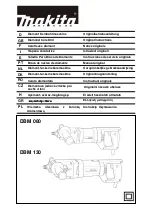
9
6.
How
to
select
tightening
torque
and
rotational
speed
Table
4
Use
Clutch
Dial
Position
Rotating
speed
selection
(Position
of
the
shift
knob)
LOW
(Low
speed)
HIGH
(High
speed)
Driving
Machine
screw
1
–
22
For
6
mm
or
smaller
diameter
screws.
For
6
mm
or
smaller
diameter
screws.
Wood
screw
1
–
For
6
mm
or
smaller
nominal
diameter
screws.
For
3.8
mm
or
smaller
nominal
diameter
screws.
Drilling
Brick
For
13
mm
or
smaller
diameters.
For
8
mm
or
smaller
diameters.
(DV14DVC2)
For
10
mm
or
smaller
diameters.
(DV18DVC2)
Wood
For
32
mm
or
smaller
diameters.
(DV14DVC2)
For
18
mm
or
smaller
diameters.
(DV14DVC2)
For
38
mm
or
smaller
diameters.
(DV18DVC2)
For
22
mm
or
smaller
diameters.
(DV18DVC2)
Metal
For
drilling
with
a
metal
working
drill
bit.
CAUTION
○
The
selection
examples
shown
in
Table
4
should
be
considered
as
general
standard.
As
di
ff
erent
types
of
tightening
screws
and
di
ff
erent
materials
to
be
tightened
are
used
in
actual
works
proper
adjustments
are
naturally
necessary.
○
When
using
the
combi
drill
with
a
machine
screw
at
HIGH
(high
speed),
a
screw
may
damage
or
a
bit
may
loose
due
to
the
tightning
torque
is
too
strong.
Use
the
combi
drill
at
LOW
(low
speed)
when
using
a
machine
screw.
NOTE
The
use
of
the
battery
BCC1412
and
BCC1812
in
a
cold
condition
(below
0
degree
Centigrade)
can
sometimes
result
in
the
weakened
tightening
torque
and
reduced
amount
of
work.
This,
however,
is
a
temporary
phenomenon,
and
returns
to
normal
when
the
battery
warms
up.
7.
Mounting
and
dismounting
of
the
bit
(1)
After
inserting
a
driver
bit,
etc.
into
the
keyless
drill
chuck,
fi
rmly
grasp
the
ring
and
tighten
the
sleeve
by
turning
it
toward
the
right
(in
the
clockwise
direction
as
viewed
from
the
front)
(See
Fig.
9
).
○
If
the
sleeve
becomes
loose
during
operation,
tighten
it
further.
The
tightening
force
becomes
stronger
when
the
sleeve
is
tightened
additionally.
(2)
Dismounting
the
bit
Firmly
grasp
the
ring
and
loosen
the
sleeve
by
turning
it
toward
the
left
(in
the
counter-clockwise
direction
as
viewed
from
the
front)
(See
Fig.
9
).
CAUTION
When
it
is
no
longer
possible
to
loosen
the
sleeve,
use
a
vise
or
similar
instrument
to
secure
the
bit.
Set
the
clutch
mode
between
1
and
11
and
then
turn
the
sleeve
to
the
loose
side
(left
side)
while
operating
the
clutch.
It
should
be
easy
now
to
loosen
the
sleeve.
8.
Con
fi
rm
that
the
battery
is
mounted
correctly
9.
Check
the
rotational
direction
The
bit
rotates
clockwise
(viewed
from
the
rear
side)
by
pushing
the
R-side
of
the
selector
button.
The
L-side
of
the
selector
button
is
pushed
to
turn
the
bit
counterclockwise
(See
Fig.
10
)
(The
and
marks
are
provided
on
the
body).
CAUTION
Always
use
this
unit
with
clockwise
rotation,
when
using
it
as
an
impact
drill.
10.
Switch
operation
○
When
the
trigger
switch
is
depressed,
the
tool
rotates.
When
the
trigger
is
released,
the
tool
stops.
○
The
rotational
speed
of
the
drill
can
be
controlled
by
varying
the
amount
that
the
trigger
switch
is
pulled.
Speed
is
low
when
the
trigger
switch
is
pulled
slightly
and
increases
as
the
trigger
switch
is
pulled
more.
NOTE
A
buzzing
noise
is
produced
when
the
motor
is
about
to
rotate;
This
is
only
a
noise,
not
a
machine
failure.
11.
For
drilling
into
brick
Excessive
pressing
force
never
increases
drilling
speed.
It
will
not
only
damage
the
drill
tip
or
reduce
working
e
ffi
ciency,
but
could
also
shorten
the
service
life
of
drill
bit.
Operate
the
combi
drill
within
10-15
kg
pressing
force
while
drilling
into
brick.
12.
Using
the
bit
holder
CAUTION
○
Stow
the
bit
in
the
speci
fi
ed
location
on
the
tool.
If
the
tool
is
used
with
the
bit
stowed
improperly,
the
bit
may
fall
and
cause
bodily
injury.
○
Do
not
stow
bits
that
are
of
a
di
ff
erent
length,
gauge
or
dimension
than
the
plus
driver
bit
(65
mm
long)
included
in
the
STANDARD
ACCESSORIES.
The
bit
may
fall
and
cause
bodily
injury.
(1)
Removing
the
bit
Securely
hold
the
main
unit
and
pull
out
the
bit
by
holding
the
tip
with
your
thumb
(
Fig.
11
).
(2)
Installing
the
Bit
Install
the
bit
with
steps
opposite
of
when
removing.
Insert
the
bit
so
that
the
right
and
left
sides
are
equal,
as
shown
in
Fig.
12
MAINTENANCE
AND
INSPECTION
1.
Inspecting
the
tool
Since
use
of
as
dull
tool
will
degrade
e
ffi
ciency
and
cause
possible
motor
malfunction,
sharpen
or
replace
the
tool
as
soon
as
abrasion
is
noted.
2.
Inspecting
the
mounting
screws
Regularly
inspect
all
mounting
screws
and
ensure
that
they
are
properly
tightened.
Should
any
of
the
screws
be
loose,
retighten
them
immediately.
Failure
to
do
so
could
result
in
serious
hazard.
000Book̲DV14DVC2̲Eng.indb 9
000Book̲DV14DVC2̲Eng.indb 9
2013/02/27 14:09:32
2013/02/27 14:09:32


































